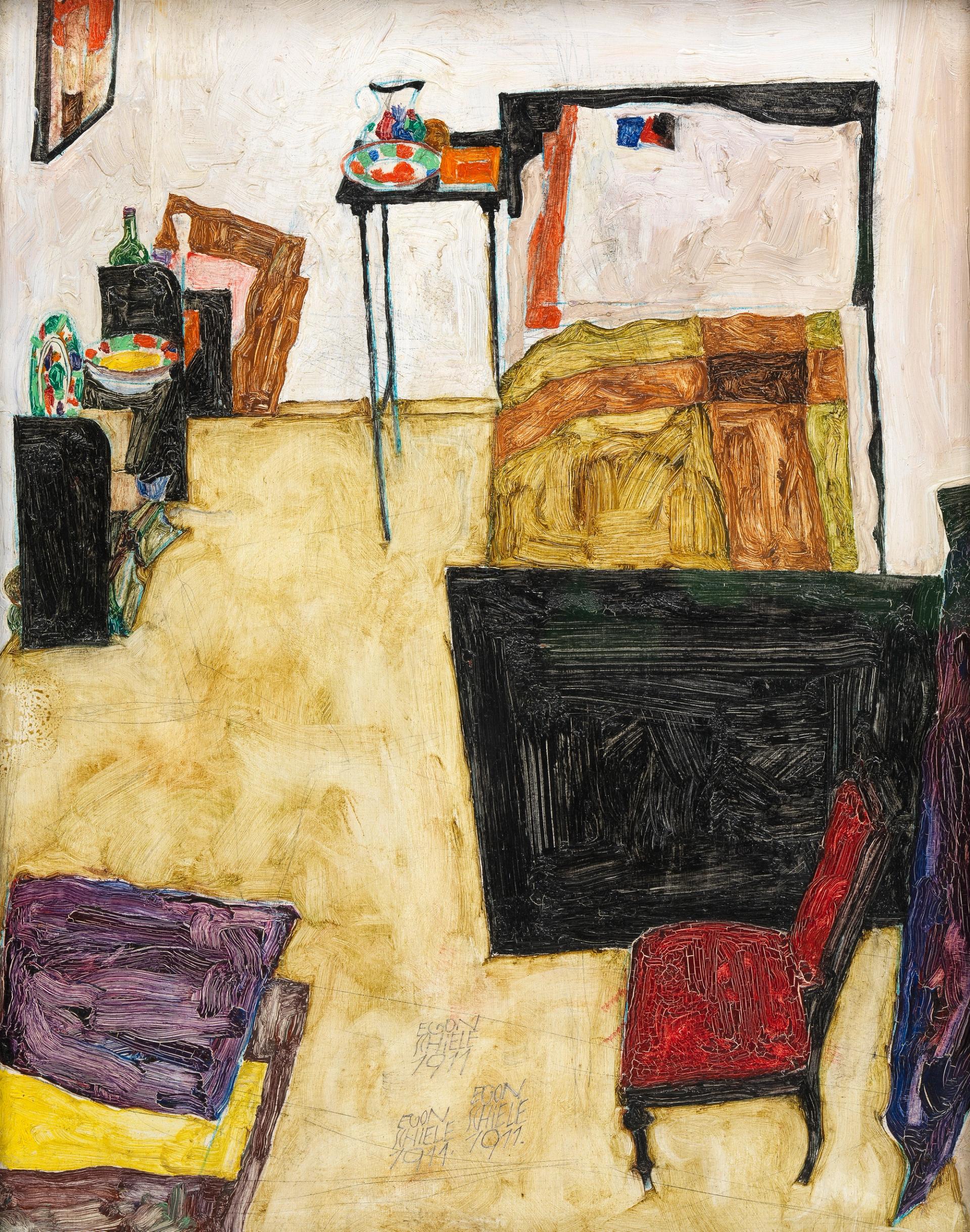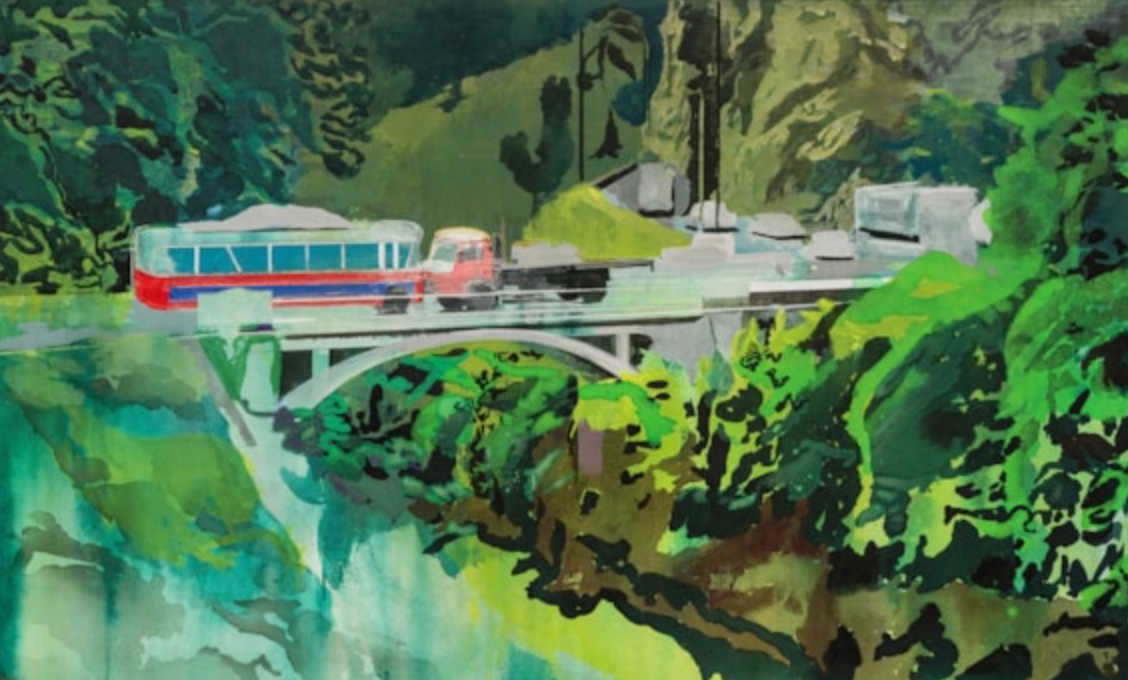Among the paintings in Tate Modern’s exuberant show Expressionists: Kandinsky, Münter and the Blue Rider (until 20 October) is one—depicting an artist’s bedroom—that was inspired by a Van Gogh. Kandinsky, the star of the Tate exhibition, was a co-founder of the Der Blaue Reiter (Blue Rider) group in Munich in 1914, and along with his colleagues was a great admirer of the Dutchman.
Until Van Gogh, artists’ bedrooms were an unusual subject to paint, but as a highly personal motif they offer considerable scope for artistic exploration. In our time, Tracey Emin has exploited this in her intimate and provocative installation My Bed (1988), featuring the detritus of her complicated life. Bedroom-related works reveal much about the personality and lifestyle of their artists.
Kandinsky had seen the first version of Van Gogh’s The Bedroom (October 1888) in an exhibition in Munich in 1909, a show which encouraged him to make even bolder use of colour.
Kandinsky’s Bedroom (1909) depicts a rather more comfortable abode than that of Van Gogh. In the painting Kandinsky’s window is uncovered, giving an airy feel, contrasting with the Dutchman’s shuttered room. The dining table with its pair of cups and slippers under the bed add a welcoming touch.

Wassily Kandinsky’s Bedroom (Schlafzimmer) (1909)
Lenbachhaus, Munich
Curiously, Van Gogh included two pillows in his painting, while Kandinsky depicts a single, enormous one. Despite his pair of pillows, Van Gogh had no partner in the Yellow House in Arles (although he would have liked to have had one). Kandinsky’s personal life was complicated: by 1909 he was still married to his cousin Anja Chimiakin, but they were separated and he was engaged to his fellow Blue Rider artist Gabriele Münter, with whom he was living in Munich.
Both paintings illustrate just how much Modern art had moved on in the intervening 21 years. Kandinsky’s colours are brighter and harsher than Van Gogh’s. The brushwork in the Kandinsky is even looser, a hallmark of the Blue Rider group. But the two artists, a generation apart, still had much in common: in depicting their bedrooms, their intention was to be expressive, not to provide an accurate representation.

Egon Schiele’s My Room (Das Zimmer des Künstlers in Neulengbach) (1911)
CC BY 4.0 Wien Museum, Vienna
Kandinsky was not the only Expressionist to be inspired by Van Gogh’s Bedroom. Egon Schiele, then a young Viennese artist, painted My Room (1911) two years after Kandinsky. Schiele was living at the time in Neulingbach, a small town 40 kilometres west of Vienna. (Although Schiele was an Expressionist, he was not a member of the Blue Rider, so is not represented in the current Tate show.)
Schiele, like Kandinsky, was a loyal devotee of Van Gogh. He had seen the second version of Van Gogh’s The Bedroom in a 1909 exhibition in Vienna and had got to know its owner, the wealthy brewer Carl Reininghaus, whose home he visited.

Van Gogh’s The Bedroom (September 1889), the second version now in Chicago
Art Institute of Chicago. CC0 Public Domain Designation
In contrast with Van Gogh’s intention to create a restful scene, Schiele’s room seems deliberately disturbing, with its sharp, angular furniture, including an uncomfortable bed. The perspective presents a bird’s eye view and the stark, claustrophobic room appears akin to a prison cell. In muted colours, it is suggestive of a tortured psyche, quite different from Kandinsky’s rendering.
A year after painting his room, Schiele was in fact sent to prison for three weeks. In April 1912 he was arrested, charged with seducing a 12-year-old girl and allowing her to see erotic drawings. In the end he was found guilty only of the erotica charge. As he exercised in prison, his thoughts turned to Van Gogh’s painting The Prison Courtyard (February 1890), which was based on a print of Newgate Prison by Gustave Doré.
Both Kandinsky and Schiele, like most of their avant-garde colleagues, were inspired by a range of Van Gogh’s work, not simply his bedroom painting. Max Pechstein, one of the earliest Expressionists, spoke for them when he declared that “Van Gogh was the father of us all!”






